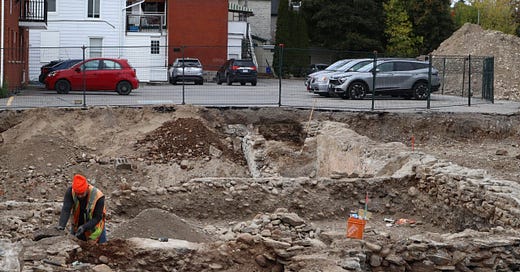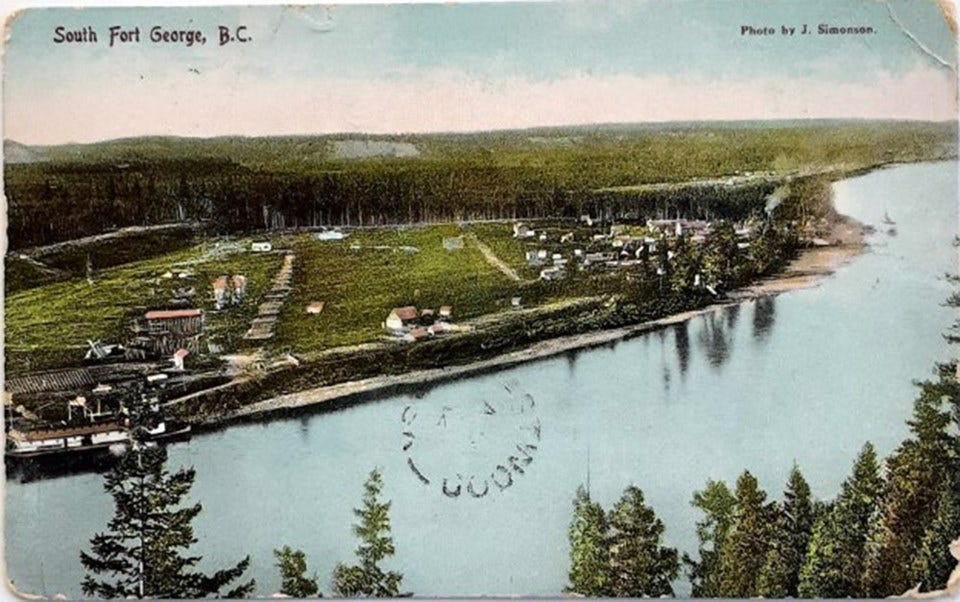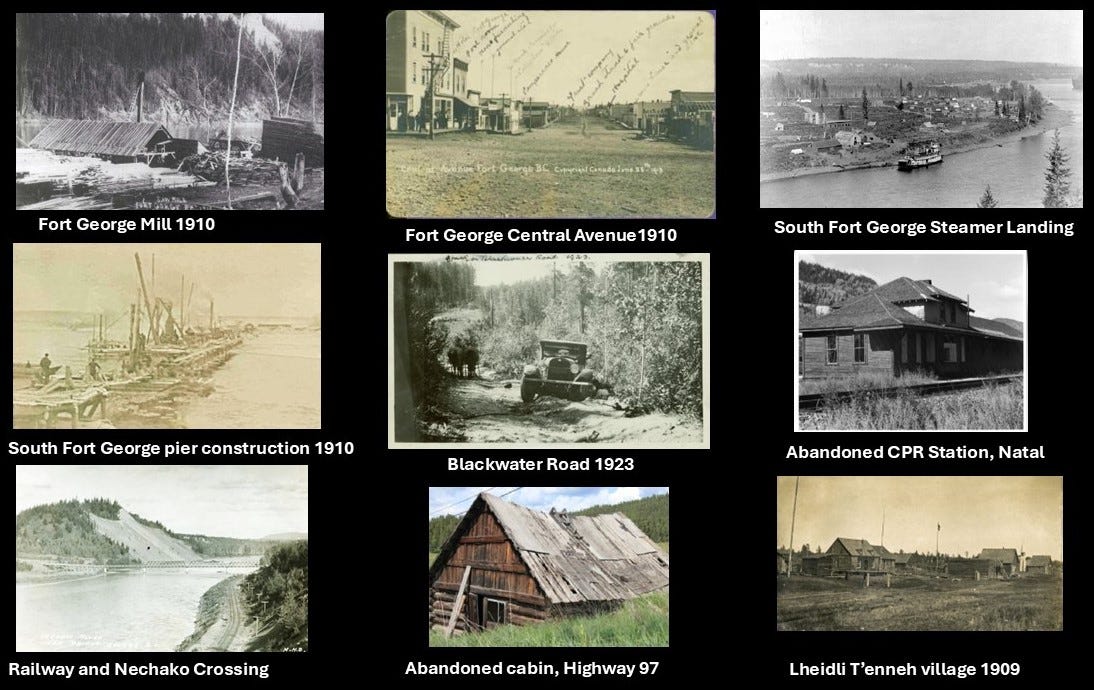Welcome to NORTHERN HERITAGE Newsletter #9 and thank you for joining our journey of discovery into the heritage of Prince George and Northern BC.
Archaeologists unearth foundations of a 19th century church in downtown Peterborough, Ontario (Photo: Brett Throop)
What Archaeology Is and Isn’t
The BC Heritage Conservation Act (HCA) (1994), interestingly, does not refer to ‘archaeology’, neither sites nor the archaeological methodologies used to reveal and study buried remains. Instead, it talks about “land, including land covered by water, that has heritage value to British Columbia, a community, or an aboriginal people”. Any such land with material pre-dating 1846, is automatically protected by the Act.
However, this means that buried archaeological sites/deposits from after 1846 are not protected within the HCA, and BC Archaeological Impact Assessment Guidelines 1998 do not apply. So when a major development is taking place and it may affect pre-1846 sites there is a legal requirement for Archaeological Impact Assessment (AIA); but if sites post-1846 are under threat, no AIA is needed. These archaeological deposits are lost.
What does this mean for the archaeological heritage of Prince George and the North?
Industrial Archaeology of Prince George and the North — Unprotected
In Newsletter #4 (Feb. 21, 2025) I discussed the Industrial Heritage and Industrial Heritage Landscapes all around us, how they reflect the values of the city and area’s working history and how Industrial Heritage can be made to work for the community.
Some of this rich Industrial Heritage is standing in full view or visible concealed in the brush. Think of remnants of old homesteads, collapsed railway buildings and work yards, long abandoned mills and logging camps, early trails and roads, and remains of river piers….
But much more of it is underground (archaeological) and post 1846 (unprotected).
Historical Archaeology Under the City — Unprotected
And what about the remains of the original townsites of South Fort George, Fort George, Central Fort George and all the additions — what are the chances that physical evidence of these early settlements remains underground? and can it be retrieved?
The answers to both questions is definitely "‘Yes’. If earlier settlements survive and have been excavated beneath Athens and Shanghai then 19th and 20th century Prince George is just waiting beneath your feet to be revealed by archaeologists.
Look at the examples of Canton Alley, a turn of the century brothel area in Vancouver’s Chinatown excavated beneath a Pender Street carpark; or the exposure of Fairbanks’ formative waterfront area that found Gold Rush saloons, a company dock and a hardware store.
Closer to home, excavation of Barkerville’s Chi Kung Tong building revealed three sequential sets of building footings spanning the 1870s to 1980s, plus over six thousand artefacts, fauna, and botanical remains.
Early Prince George 115 years ago - is it underground, waiting to be revealed?
Archaeology under and along the Rivers? - Unprotected
For a century the Nechako and Fraser were navigated by paddlewheel steamers working on rail construction, delivering mail and settlers (1863-1921); cable ferries crossed between banks, bridges were built and commercial scows plied freight, horses and men over a wide river network. Do the rivers hold remains of sunken boats and lost shipments? Is there evidence along the extensive shorelines of landings, moorings, wharves, boat-works, warehouses, shipping offices? Docks such as the 1913 dock built by Foley, Welch & Stewart at Foley’s Cache where the steamers Conveyor and Operator were built?
Remains of early steamboats in the Paddlewheel Graveyard, Dawson City (Photo: GordMcKenna / Atlas Obscura User)
This extended and intensive industrial use of the confluence will have left remains and they are archaeologically retrievable. Look at the wrecks of Gold Rush sternwheelers in the Yukon, the company dock and river bank dump excavated in Fairbanks, or the ‘Paddlewheel Graveyard” near Dawson City…..
1912 Postcard of South Fort George, the Fraser and Paddlewheel Steamer
How can we safeguard archaeological heritage?
Virtually all of the archaeology of Prince George and the North dating to after 1846 is unprotected by Provincial legislation. The only way it can be protected is at the local City government level by being placed on the Community Heritage Register and, in particularly valuable cases, being Designated by the City Council to give it full legal protection.
The Heritage Commission Bylaw No. 8133 (2008) states:
3. SCOPE AND DUTIES
3.2 The Commission shall investigate and report to Council on any building, structure, land, water, natural feature or flora within the City which the Commission considers may have historic, architectural, geological, scenic or other heritage significance to the City, or any such site referred to it by the Council.
Here is where it gets tricky….
Archaeology is not listed here as part of the Commission’s terms of reference; it can’t be because all archaeology is managed by the BC Provincial Government and dates to before 1846. This implies that ‘archaeology’ from after 1846 is (a) not archaeology and (b) not managed by anyone.
But what about all the heritage we have discussed above? Isn’t it ‘archaeological’?
Parks Canada defines an archaeological site as “ a surface vestige or the subsurface or submerged remains of human activity at which an understanding of these activities and of the management of these resources can be achieved through the employment of archaeological techniques.”
On the basis of this definition, all the potential and predicted sites and deposits we have discussed here, under Prince George, scattered throughout the rural North and under and along its rivers are unquestionably archaeology.
But because of their dating they can only be protected by the City and the Heritage Commission BUT not as archaeology. They have to be re-defined as “building, structure, land, water, natural feature or flora”. (I don’t know if this makes sense and whether I have succeeded in explaining the inexplicable… I admit that it has taken me quite some time to figure it all out and I’m still a bit uncertain.)
We need Cultural Landscape Projects incorporating Archaeology
I am not speaking for the Community Heritage Commission here, only for myself, when I say that I will happily vote for protection of local archaeological sites using alternative labels. The most promising is the label I talked about in an earlier Post, the Cultural Landscape, resulting from nature influencing and molding human activity and that activity, over time, altering and re-structuring the natural landscape.
A proposal is needed for a comprehensive Industrial Cultural Landscape Study, combining historical research, archaeological survey and excavation, built heritage studies, and oral history of the logging industry, river transport, early roads and trails, the railway and historical settlements — something for us all to think about for the near future!








